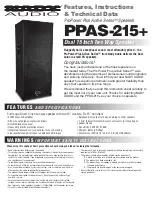
15
Room Acoustics & Placement
Wisdom Audio believes in equalization. Assume for a moment that you had a
“perfect” loudspeaker: as soon as you place it in your room, its perfection is
gone. In fact, even good rooms often introduce deviations of 20 dB to the re-
sponse of the system.
It seems strange to us to worry about tenths-of-a-decibel differences between
one component and another when there are 10-20 dB problems right there in
the room with you.
At the same time, room equalization is not a panacea. It does not solve all prob-
lems. In fact, and somewhat paradoxically, EQ works best when it has the least
to do. It is best used as the “finishing touch” on an otherwise good system. Un-
fortunately, most people do not understand that the most important component
in their system is their listening room.
This manual does not have the space for a full description of everything that
goes into creating excellent room acoustics; doing so would require a textbook
of several hundred pages. Instead, we will give you some ideas, and some refer-
ences to pursue should you want to learn more.
Start With the Room
There are many myths floating around pertaining to what a “good room” should
be like. One of the most common is that it should have non-parallel walls. With-
out going into the details, we recommend staying with rectangular rooms whose
dimensions do
not
share common divisors.
Thus a room with dimensions of 8’ by 16’ by 20’ would be quite poor (since the
dimensions are all divisible by a length of 4’, and 16 is also multiple of 8). By
contrast, a room whose dimensions are 9’ by 16’ by 29’ would be much better,
since none of the dimensions are mathematically related to one another.
There are infinite variations on this idea. If you have the flexibility to choose (or
modify) your room dimensions to avoid such problems, do so. Either way, our
room correction will be a big help.
Rigid Walls
Another myth that should be dispelled is the notion that the walls (and ceiling
and floor) of the room should be extremely rigid in order to reproduce good
bass. Rigid, inflexible walls reflect energy extremely well; thus you will keep
more of the bass energy in the room. This much is true. However, those rigid
walls will only increase the amplitude of the standing waves that your room
naturally supports. In simple terms, you will have more bass, but it will also be
more irregular, with larger peaks and valleys in the response.
Walls that flex a bit (but do not rattle) are much better. Coincidentally, tradition-
al American residential construction standards (sheet rock on wooden studs) are
not a bad place to start. You can do better still with professional help, but studs
and sheet rock are better than poured concrete. (If your listening room is in the
basement, a false wall can easily be built in front of the concrete. You probably
need something like this for insulation and aesthetics anyway.)
The ultimate in dedicated listening room construction involves the design and
construction of floating walls, ceiling and floor. This approach yields the added
Содержание Saga C38i
Страница 1: ...Owner s Manual Sage P48 P38m P38i Biamplified Planar Magnetic Hybrid Loudspeakers ...
Страница 3: ......
Страница 25: ...25 P48 Dimensions ...
Страница 26: ...26 P38m Dimensions ...
Страница 27: ...27 P38i Dimensions ...
Страница 28: ...28 Notes ...
Страница 29: ...29 ...
















































